

Di-Namix
Productions
began as Di-Namix D.J. in August of 1991. It consisted of my high school
friend Chris and me. We had a huge interest in popular music, which
prompted us to start buying D.J. equipment. Our first "gig" was a street
dance in Sunfield, Michigan, which was part of the small town's "Farmer's
Picnic" celebration. Being avid music collectors, we had all the necessary
dance music for that night (some of it was still on vinyl). I think
we were paid $100 for our first D.J. experience -- not bad.
Then on the week of August 31, 1991, I had the idea of publishing our
own music chart. Thinking the chart would last maybe a few weeks, I
sat down at my Apple IIgs computer (!) and typed up a list of what I
thought should be the Top 20 tunes. The Di-Namix Top Hits Chart was
born (click here to see
what the very first chart looked like)!
Since those
early days, Chris has earned his Master's Degree from the University of
Michigan, and is busy in his chosen field of architecture. I am a graduate
of Michigan State University, and worked in the radio industry for more
than 14 years.
Our D.J. duo only lasted a few months, but Chris & I still keep in
touch. My interest in music is stronger than ever, and the chart keeps
going strong, reflecting the newest and hottest music each week. Thanks
for visiting the site -- come back every week to see the hottest Di-Namix
hits!
|

A
TOUR OF THE DI-NAMIX CHART:
The
Di-Namix chart has evolved greatly since its creation in 1991.
The following is a history of the chart's changes, along with
photos of actual charts and explanations of how the chart
developed into its present form. Click on the photos for a
larger view of each historic chart.
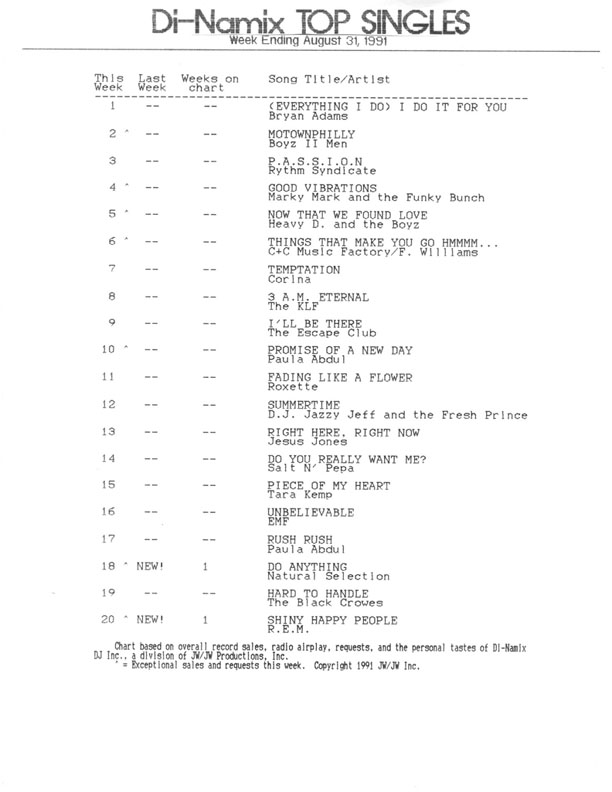 Our tour of the Di-Namix chart begins on the very
first week, August 31, 1991. The idea of a weekly chart to
keep track of the hottest hits arose from the creation of
Di-Namix DJ, a mobile DJ service I founded earlier that month
with a high school friend. The simple chart (left) was created
on my Apple IIgs computer system, using word processing software
that was outdated even then.
Our tour of the Di-Namix chart begins on the very
first week, August 31, 1991. The idea of a weekly chart to
keep track of the hottest hits arose from the creation of
Di-Namix DJ, a mobile DJ service I founded earlier that month
with a high school friend. The simple chart (left) was created
on my Apple IIgs computer system, using word processing software
that was outdated even then.
The first number one song was Bryan Adams' "(Everything I
Do) I Do It For You," and there were two actual debuts that
week. They were "Do Anything" by Natural Selection Featuring
Niki Haris and "Shiny Happy People" by R.E.M. The other 18
songs on that first chart were placed as if they had already
established a spot on the chart. There was no Hot Shot Debut
or Power Pick Hit designation on the first chart. In fact,
these designations didn't show up until the September 21 chart.
They have been important features ever since. For point calculation
purposes, "Do Anything" was the un-named Power Pick hit on
September 7, 1991; and "I Adore Mi Amor" by Color Me Badd
claimed the unwritten honor for September 14. The Hot Shot
Debuts would have been "Do Anything" on August 31, "I Adore
Mi Amor" on September 7 and "Time, Love And Tenderness" by
Michael Bolton on September 14. "My Name Is Not Susan" by
Whitney Houston was the actual Hot Shot Debut on September
21, but the chart mistakenly listed "Kiss Them For Me" by
Siouxsie & The Banshees as the Hot Shot that week. There were
many small errors on the early charts, such as misspelled
and wrongly-titled entries (in fact, "Siouxsie" was misspelled
on that September 21 chart). The Hot Shot and Power Pick errors
have been corrected on the main point spreadsheet, so proper
credit is given.
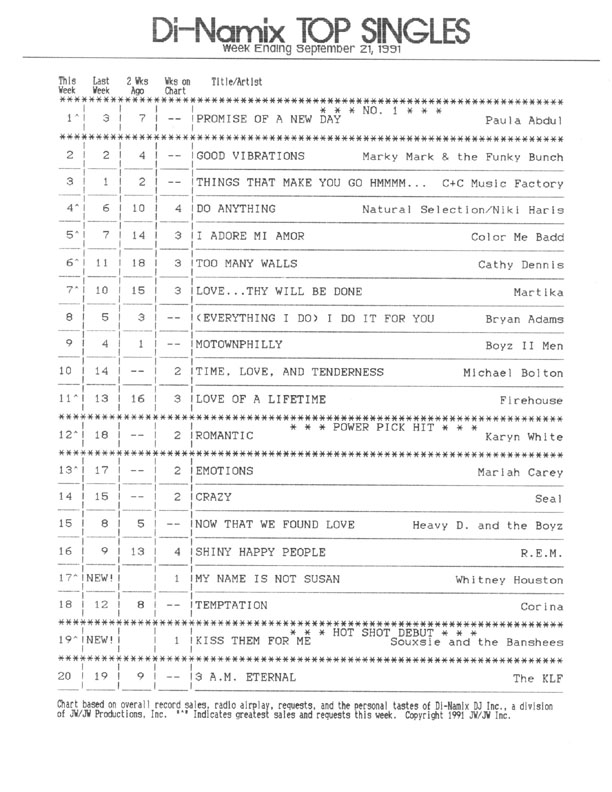 As
you can see by the September 21 chart (left), the layout was
changed after the first three charts. It was redesigned to
more closely resemble the Billboard Hot 100 chart, but due
to extreme limitations on that old computer system, it still
appeared crudely designed. As
you can see by the September 21 chart (left), the layout was
changed after the first three charts. It was redesigned to
more closely resemble the Billboard Hot 100 chart, but due
to extreme limitations on that old computer system, it still
appeared crudely designed.
Each week, I had to print the letterhead using The Print Shop,
then re-insert the paper and print the chart using Appleworks
word processing software.
The "bullets" on the first several charts were simply a caret
(^) character placed next to the position number. Due to the
fixed width of the font, several titles and artist names had
to be abbreviated.
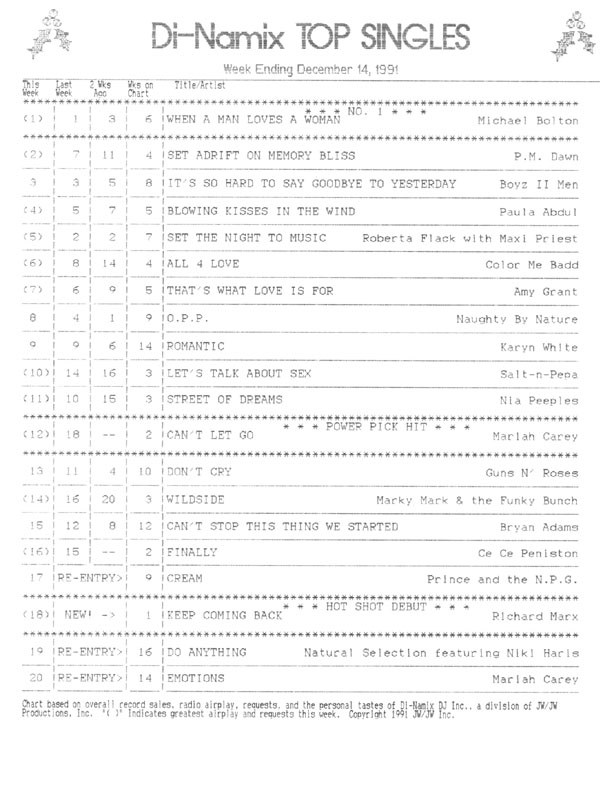 As the early chart slowly evolved, changes included wider
margins, beginning with the November 2, 1991 chart. On November
30, the "NEW! '" designation for debuting songs was expanded
across the "Last Week" and "2 Weeks Ago" columns, for a more
balanced look. The December 14 chart (left) introduced new
bullets, surrounding the position numbers with parentheses,
instead of the harder-to-see caret mark.
As the early chart slowly evolved, changes included wider
margins, beginning with the November 2, 1991 chart. On November
30, the "NEW! '" designation for debuting songs was expanded
across the "Last Week" and "2 Weeks Ago" columns, for a more
balanced look. The December 14 chart (left) introduced new
bullets, surrounding the position numbers with parentheses,
instead of the harder-to-see caret mark.
On December 28, 1991, the chart was not intended to be an
official tally, since the National charts also "froze" their
charts at the year's end. In 1997, this "unofficial" chart
was reinstated and included in the point spreadsheet. It was
determined that there was no legitimate reason to leave this
week out. Consequently, "Set Adrift On Memory Bliss" by PM
Dawn became an official Number One song, as it had peaked
that week.
More features were added to the chart in 1992. A listing of
movie titles next to soundtrack songs began on August 22.
This space-consuming practice was discontinued on March 11,
1995, when "Here Comes The Hotstepper (From 'Ready To Wear')"
exited the chart. On September 12, 1992, a much needed "weeks
at No. 1" designation was added to the top song, making it
easier to see how long a song had been Number One. A chart
"volume and number" indication appeared on the September 19,
1992 chart, and continues today. The "volume" indicates the
year of the chart, and the "number" indicates the week. For
instance, "Chart Vol. 2, No. 3" indicated the 2nd year and
3rd week of the chart on September 19, 1992. The December
27, 2008 chart shows "Vol. 18, No. 18."
A strange occurrence took place at the end of 1992. There
was no December 26 chart printed. Therefore, the "Last Week"
and "2 Weeks Ago" columns of the January 2, 1993 chart were
the same. Therefore, it was determined that the Top 20 songs
"held" their positions for the final week of 1992, and Whitney
Houston's "I Will Always Love You" officially spent 11 weeks
at No. 1. A similar thing happened again at the end of 1993.
No chart was printed for December 25. However, the "Last Week"
column of the January 1, 1994 chart reflected the positions
of the December 18 chart, simply overlooking that last week
of 1993.
Beginning on January 1, 1994, the chart heading was changed
from "Compiled from radio airplay and sales data, along with
personal tastes of Di-Namix D.J." to "Compiled from weekly
radio airplay data, along with chart criteria developed by
Di-Namix." The old heading had been in place for exactly two
years. The Billboard charts had been an early basis for the
Di-Namix chart, which is why sales data had been mentioned.
"Chart criteria" also sounded more scientific than "personal
tastes." Sales data continued to be mentioned in the small
print at the bottom of the page.
 The
biggest visual change happened on April 16, 1994 (left). A
new computer system was acquired, which allowed the chart
to undergo a major overhaul. Colors were added to the bullets,
Hot Shot Debuts and Power Pick Hits. Shading, continuous borders
and high-resolution fonts gave the chart a spectacular new
look. Songwriter info, record label listings and catalog numbers
were added, as was the number of hits each artist had charted.
"Source" letters indicated if a song was on cassette single,
CD, etc. in the Di-Namix collection. The
biggest visual change happened on April 16, 1994 (left). A
new computer system was acquired, which allowed the chart
to undergo a major overhaul. Colors were added to the bullets,
Hot Shot Debuts and Power Pick Hits. Shading, continuous borders
and high-resolution fonts gave the chart a spectacular new
look. Songwriter info, record label listings and catalog numbers
were added, as was the number of hits each artist had charted.
"Source" letters indicated if a song was on cassette single,
CD, etc. in the Di-Namix collection.
The chart underwent a few minor changes after its major redesign
in 1994. The color for the Hot Shot Debut changed from red
to its present-day green on May 21, 1994. Beginning in 1995,
a "20" was added to the chart's name, and it became "Di-Namix
Top 20 Singles." The font used in the chart's body was changed
slightly, to be more reader-friendly. The No. 1 position also
got a red highlight, and the "weeks at No. 1" indicator moved
under the "1" in the "This Week" column.
On August 26, 1995, a very useful feature appeared for the
first time. The "peak position" column on the right-hand edge
of the chart made it much easier to follow a song's history.
On the January 6, 1996 chart, the "airplay and sales data"
mention was finally removed from the small print below the
chart.
May 3, 1997 brought more changes. Di-Namix D.J. became Di-Namix
Productions. The chart's name also changed that week, exchanging
the outdated term "singles" for "hits."
On July 26, 1997, Di-Namix Productions went online. The weekly
chart was featured on the Internet, and that Web address was
added to the bottom of the printed chart.
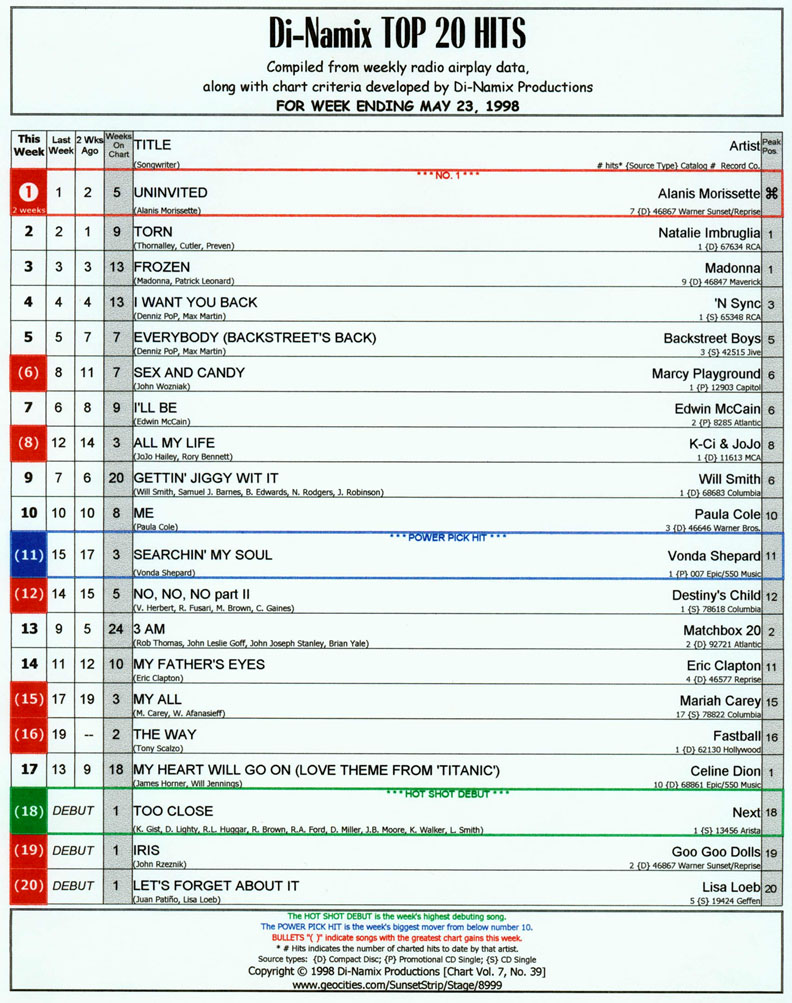 Ever
since the dawn of the chart in 1991, debuting songs were designated
as "NEW." Since not every song that enters the chart is necessarily
"new" (re-releases, for example), the designation was changed
to "DEBUT" on the May 23, 1998 chart (left). Ever
since the dawn of the chart in 1991, debuting songs were designated
as "NEW." Since not every song that enters the chart is necessarily
"new" (re-releases, for example), the designation was changed
to "DEBUT" on the May 23, 1998 chart (left).
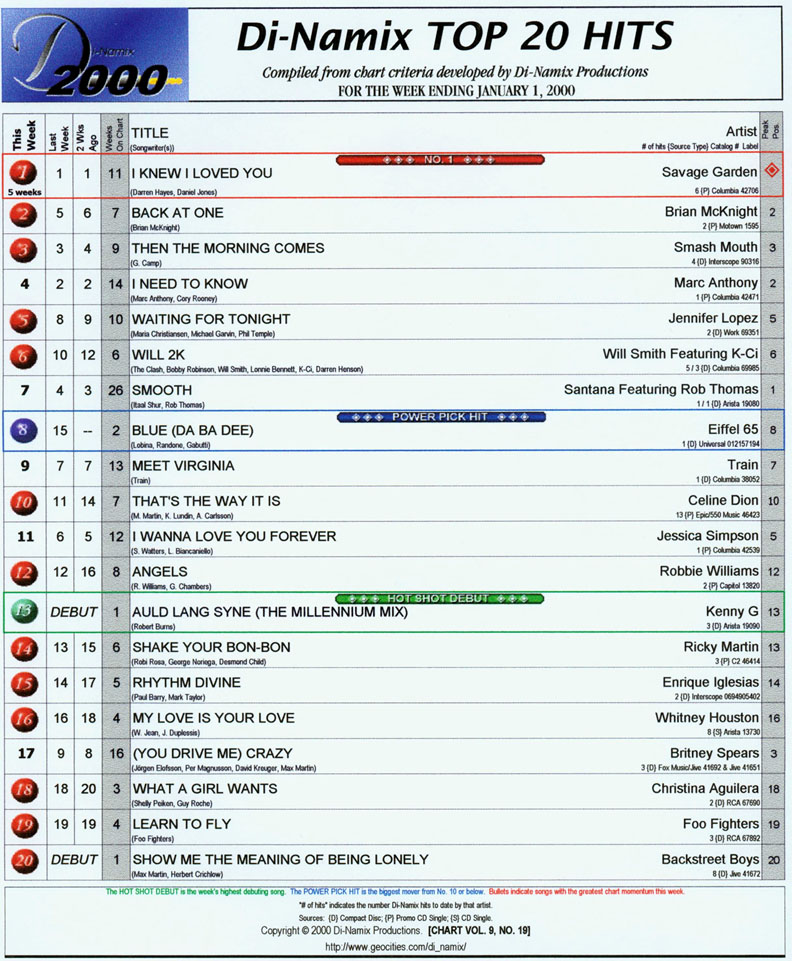 As
the new millennium dawned, a new era for the Di-Namix chart
was about to begin. On the January 1, 2000 chart (left), a
full-color graphic logo was included in the letterhead for
the first time. The heading text was also shortened from its
January 1, 1994 version. This heading is still in use today,
and states that the chart is "compiled from chart criteria
developed by Di-Namix Productions." New, graphically-interfaced
bullets, Hot Shot, Power Pick and No. 1 designations were
introduced. As
the new millennium dawned, a new era for the Di-Namix chart
was about to begin. On the January 1, 2000 chart (left), a
full-color graphic logo was included in the letterhead for
the first time. The heading text was also shortened from its
January 1, 1994 version. This heading is still in use today,
and states that the chart is "compiled from chart criteria
developed by Di-Namix Productions." New, graphically-interfaced
bullets, Hot Shot, Power Pick and No. 1 designations were
introduced.
As the early days of 2000 rolled on, the biggest change in
the history of the chart (other than the cosmetic one in 1994)
was about to occur…
 March 11, 2000 changed the Di-Namix chart forever. That week,
the chart expanded from 20 to 40 positions. This expansion
had been experimented with several times, but never put into
play. This time all the proper adjustments were made for a
smooth transition. The Top 20 version of the chart (left)
was still printed until August 25, 2001 along with the Top
40 version.
March 11, 2000 changed the Di-Namix chart forever. That week,
the chart expanded from 20 to 40 positions. This expansion
had been experimented with several times, but never put into
play. This time all the proper adjustments were made for a
smooth transition. The Top 20 version of the chart (left)
was still printed until August 25, 2001 along with the Top
40 version.
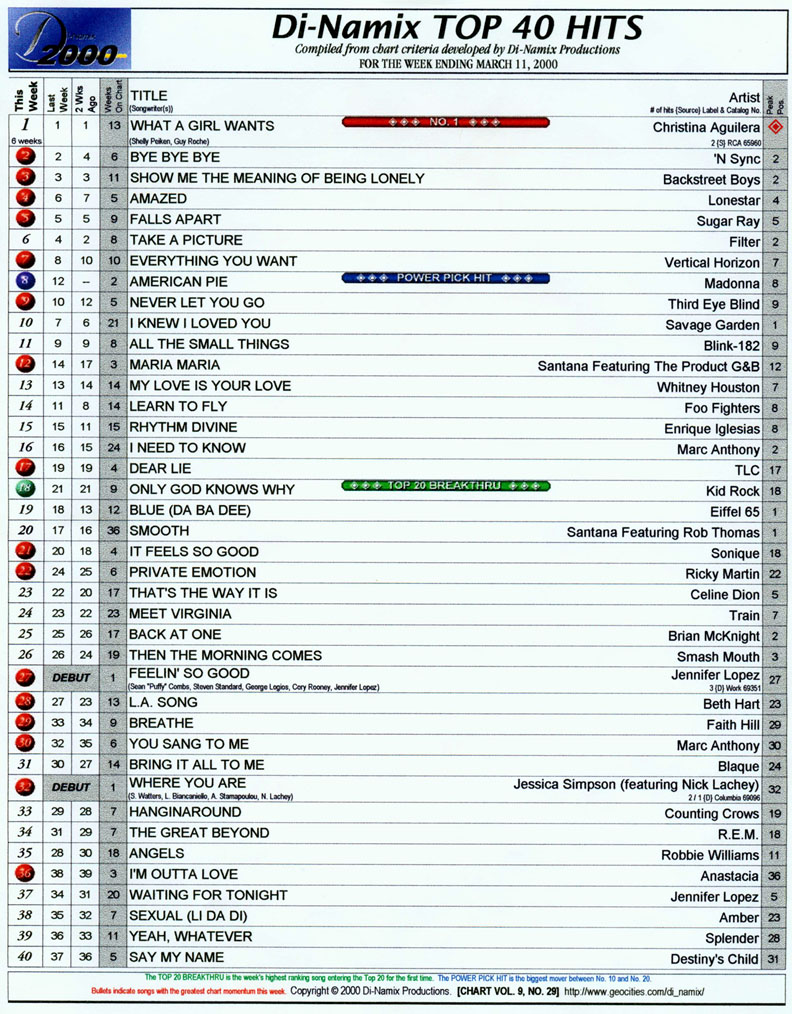 The first Top 40 chart on March 11, 2000 (left) only included
songwriter information for the songs that debuted that week.
The following week, the formatting was adjusted to allow space
for songwriter info, along with the usual information that
is included with each entry. On April 15, a narrower font
became the standard that continues today.
The first Top 40 chart on March 11, 2000 (left) only included
songwriter information for the songs that debuted that week.
The following week, the formatting was adjusted to allow space
for songwriter info, along with the usual information that
is included with each entry. On April 15, a narrower font
became the standard that continues today.
With the expanded chart came extra designations used to signify
songs that moved into the Top 20 for the first time. They
were called the Hot Shot Breakthru and the Top 20 Breakthru.
These were used in addition to the Hot Shot Debut, which signified
the highest song entering the Top 40. The Breakthru designations
were discontinued on August 19, but a Greatest Gainer designation
was added on September 23, noting the song that gained the
most places on the chart (the Power Pick Hit was still reserved
for the biggest movement within the Top 20 at that time).
The extra designations proved to be more distracting than
useful, so the chart returned to its original configuration
(Hot Shot Debut and Power Pick Hit only) on September 1, 2001.
The Power Pick Hit now stands for the biggest mover on the
entire chart, with the Hot Shot Debut remaining as the highest
new entry.
 August 25, 2001 saw the end of the Di-Namix Top 20 chart,
exactly ten years after it debuted. The Top 40 chart had been
in force for over a year and a half, and the Top 20 had been
printed along with it for continuity's sake. With the transition
to a 40-place chart complete, it was time to say goodbye to
the chart in its original format. The final Top 20 chart is
pictured (left).
August 25, 2001 saw the end of the Di-Namix Top 20 chart,
exactly ten years after it debuted. The Top 40 chart had been
in force for over a year and a half, and the Top 20 had been
printed along with it for continuity's sake. With the transition
to a 40-place chart complete, it was time to say goodbye to
the chart in its original format. The final Top 20 chart is
pictured (left).
 The chart got another fresh look on September 1, 2001 (the
first chart of its 11th year) with new bullets, as well as
new Hot Shot Debut and Power Pick Hit graphics (left).
The chart got another fresh look on September 1, 2001 (the
first chart of its 11th year) with new bullets, as well as
new Hot Shot Debut and Power Pick Hit graphics (left).
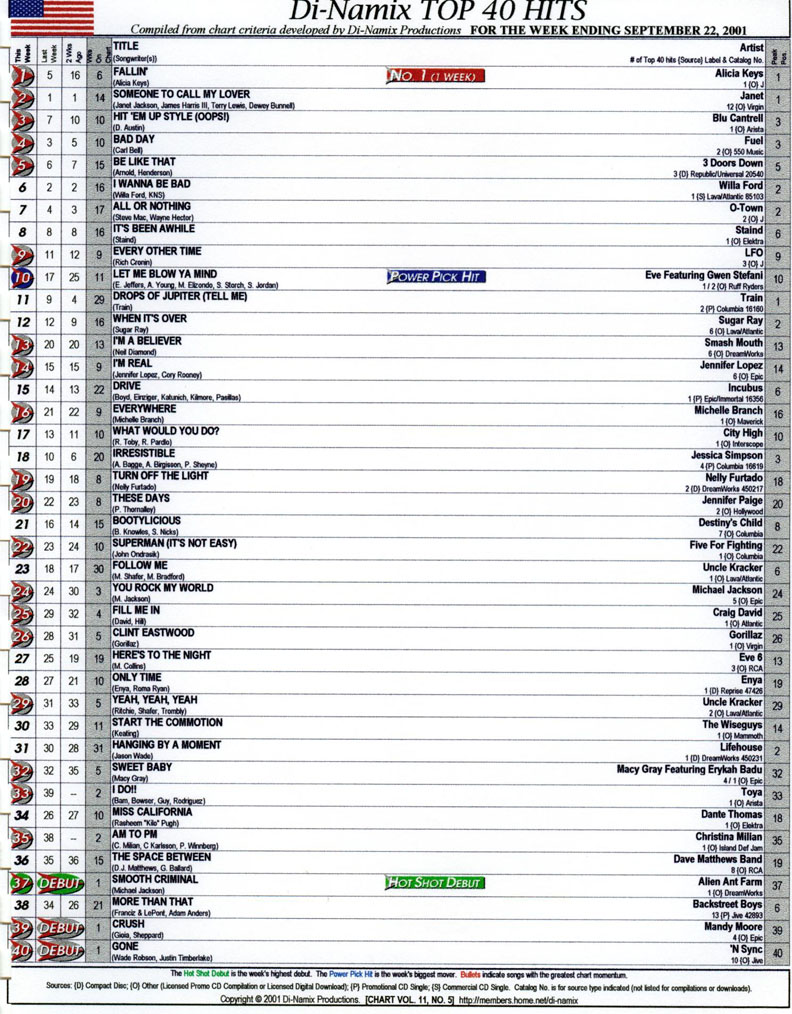 After tragedy struck on September 11, 2001, the chart's header
was changed to feature an American flag graphic, honoring
those who had lost their lives in New York City, Washington,
D.C. and Pennsylvania. The September 15 chart had been printed
prior to September 11, so the flag first appeared on the September
22 chart (left). The 2002 chart headings all featured a newly-designed,
patriotic Di-Namix logo.
After tragedy struck on September 11, 2001, the chart's header
was changed to feature an American flag graphic, honoring
those who had lost their lives in New York City, Washington,
D.C. and Pennsylvania. The September 15 chart had been printed
prior to September 11, so the flag first appeared on the September
22 chart (left). The 2002 chart headings all featured a newly-designed,
patriotic Di-Namix logo.
On April 5, 2003, the long-standing practice of placing a
"source" designation on the chart was discontinued. It had
been used to indicate what type of recording (CD single, etc.)
was in the Di-Namix collection. Promotional CD compilations
and downloaded music had taken over as the sources of most
hits appearing on the chart. Promo singles continued to be
noted with a catalog number for a short time after, but they
are no longer identified.
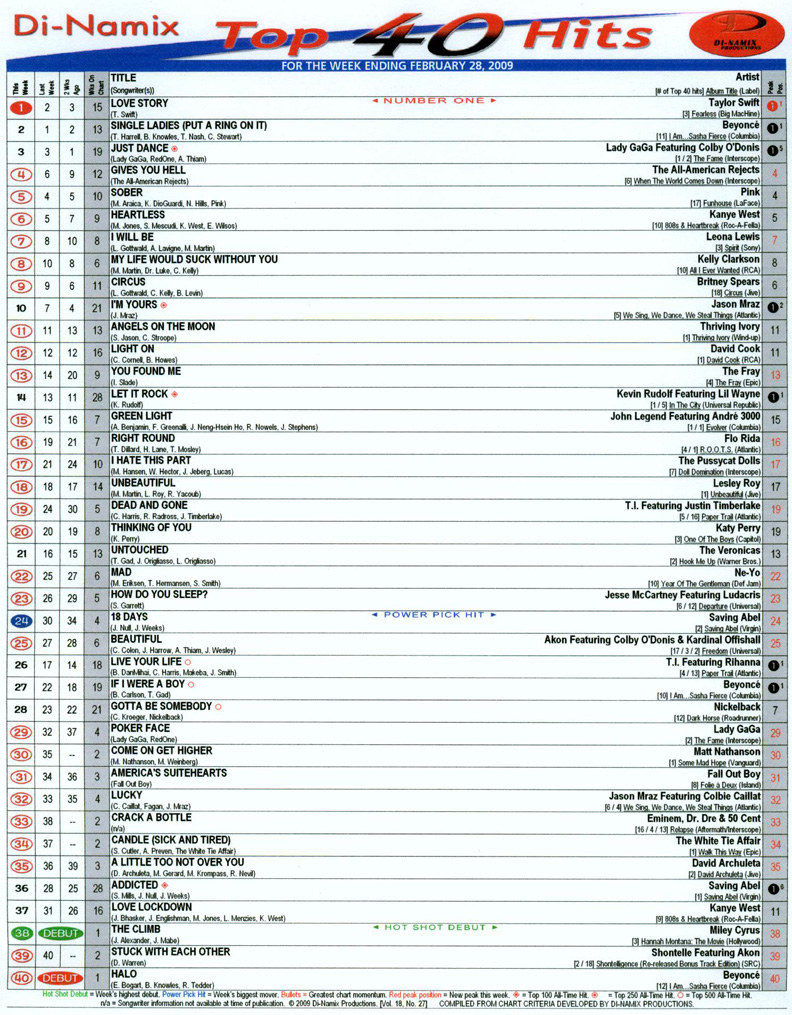 More refinements to the chart included new symbols, which
were added on May 3, 2003. Red circles with a dot in the center
were placed next to song titles for songs that achieved the
Top 250 on the all-time chart. Red diamonds indicated songs
in the all-time Top 100. Red numbers were added in the "peak
position" column to indicate songs that had achieved a new
peak that week.
More refinements to the chart included new symbols, which
were added on May 3, 2003. Red circles with a dot in the center
were placed next to song titles for songs that achieved the
Top 250 on the all-time chart. Red diamonds indicated songs
in the all-time Top 100. Red numbers were added in the "peak
position" column to indicate songs that had achieved a new
peak that week.
On September 6, a special #1 or #2 symbol with the number
of weeks at #1 or #2 was added to the "peak position" column.
This made it easier to see how long a song had stayed at or
near the top. Also, a blue snowflake symbol was used for the
first time on the December 27, 2003 chart to indicate Christmas
hits.
On January 7, 2006, a plain red circle symbol was added to
indicate songs reaching the Top 500 on the all-time chart.
The dotted circle and diamond symbols continue to indicate
Top 250 and Top 100 all-time hits.
Another feature was added on January 6, 2007. The artists'
album titles can now be found below their name, to indicate
where the hit song can be found.
From that first crude chart on August 31, 1991 to today's
fully-loaded version, the Di-Namix chart has come a long way.
The hits keep on coming, and so the evolution of the Di-Namix
Top 40 chart continues...
|
|

